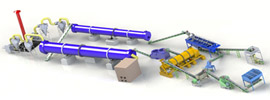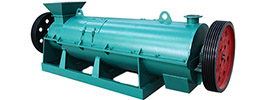To improve the granulation rate of organic fertilizer production, a comprehensive approach is needed from five aspects: raw material pretreatment, process optimization, equipment selection, post-processing, and personnel management. Here are the specific solutions:
I. Raw Material Pretreatment: The Key to the Foundation
- Fineness Control
- Raw materials should be crushed to a particle size of 0.32cm-1.27cm. The finer the particle size (e.g., passing through an 80-mesh screen), the smoother the particles.
- Example: Straw-based raw materials require two stages of crushing: initial coarse crushing to below 3cm, followed by fine crushing to a particle size of <1cm.
- Moisture Adjustment
- The moisture content of the mixed raw materials should be controlled between 50%-60%. Uneven moisture distribution can lead to inconsistent particle sizes.
- Tip: Use a spray method to add water, ensuring uniform moisture penetration and avoiding localized over-wetting or drying.
- Binder Addition
- Raw materials with poor adhesion, such as livestock manure and straw, require the addition of binders like bentonite or humic acid, at a ratio of 5%-10%.
- Alternative Solution: Natural binders like molasses or starch paste can enhance particle strength by 15%-20%.
II. Fermentation Process Optimization: Maturity Determines Plasticity
- C/N Ratio Control
- Adjust the C/N ratio of the raw materials to 25:1-30:1 to promote microbial reproduction and improve material adhesion.
- Formula Example: Chicken manure (60%) + cassava residue (20%) + straw (20%), with a C/N ratio of approximately 28:1.
- Turning and Aeration
- Turn the compost every 2-3 days during fermentation, controlling the temperature between 50℃-65℃ to prevent localized overheating and carbonization.
- Equipment Recommendation: Use a trough-type compost turner to ensure sufficient oxygen supply and uniform composting.
- pH Adjustment
- If the pH is <5.3 after fermentation, add 2%-3% lime or plant ash for neutralization. If the pH is >8.5, incorporate fresh green manure to reduce acidity.
III. Equipment Selection and Operation: Precision Control at the Core of Granulation
- Granulator Selection
- Preferred Equipment: Drum granulator, achieving a granulation rate of over 70%, with small recycled material particle size, facilitating secondary granulation.
- Alternative Solution: Double-roller extrusion granulator (for cylindrical particles with uniform size, suitable for highly viscous raw materials).
- Parameter Settings
- Rotation Speed: Set the drum granulator at 15-25 revolutions per minute to ensure an appropriate material rolling frequency.
- Inclination Angle: Adjust the drum angle to 45°-50° to balance material retention time and granulation efficiency.
- Auxiliary Measures
- Install rubber plates or acid-resistant stainless steel liners on the inner wall of the granulator to reduce wall adhesion and improve the granulation rate by 5%-8%.
- Install steam nozzles to introduce saturated steam, increasing the material temperature to 50℃-60℃ and enhancing adhesion.
IV. Post-Processing: Details Determine Quality
- Spheroidizing and Shaping
- Use a spheroidizing machine after granulation to roll the particles into balls in one pass, increasing the granulation rate by 10%-15% and particle strength by 20%.
- Drying and Cooling
- Control the drying temperature below 80℃ to prevent particle breakage, reducing the final moisture content to below 20%.
- Equipment Recommendation: Adopt a counter-flow dryer for high thermal efficiency and low particle breakage rate.
- Screening and Recycling
- Screen out不合格 particles (>4.75mm or <1mm), controlling the recycling ratio at 30%-35% to avoid excessive large particles.
V. Personnel and Formula Management: Supporting Soft Power
- Skill Training
- Hire experienced granulation operators, as their operational skills directly affect the granulation rate (skilled workers can achieve a 10%-12% higher granulation rate).
- Dynamic Formula Adjustment
- Adjust the ratio of adhesive materials based on raw material characteristics:
- Low-concentration formula: 45%-50% adhesive raw materials.
- High-concentration formula: 35%-40% adhesive raw materials.
- Example: A company increased its granulation rate from 65% to 82% by optimizing its formula.
Summary
By implementing the above measures, the granulation rate can be increased to over 80%, particle strength can be improved by 30%, and the recycling rate can be reduced to below 20%. It is recommended that enterprises prioritize optimizing the fermentation process and equipment parameters based on their raw material characteristics, and then gradually improve the post-processing flow to achieve efficient and stable particle production.
 Send us a Email
Send us a Email Wulong Industrial Cluster
Wulong Industrial Cluster Have any question?
Have any question?



















